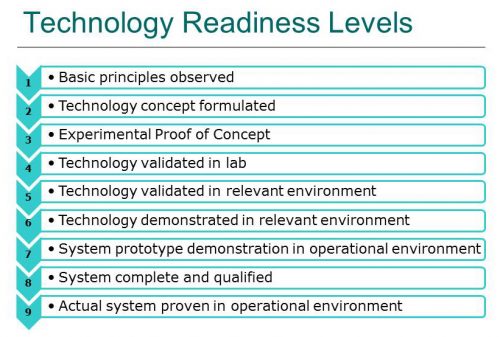
How ready is your technology for R&D grant funding?
5 June 2018When is the best time to apply for R&D grant funding when researching or developing a new technology? It’s a good question and the answer is… it depends! It depends on whether you are applying for an Innovate UK R&D grant or a European Horizon 2020 grant.
Experienced scientists and technologists will know that a new technology will go through several stages of proving and validation from the point of conception at which basic principles are observed, to the point at which a fully developed solution is released on the market. In fact, various organisations including the UK MOD, NASA and the European Commission, often use a 9-point technology readiness levels scale to define the maturity of a technology:

Clearly, the higher the Technology Readiness Level, the closer to market the technology is with more of the technical and commercial risks resolved.
R&D grants are seen by Governments as a means of using State Aid to offset the risks of bringing new technologies to market. New technologies are generally beneficial in that they often lead to economic benefits either by improving overall productivity or by creating totally new markets along with new jobs and employment. Smartphones and the whole new world of mobile apps is a classic example.
The UK and Europe offer R&D grants at different stages of technological maturity. Innovate UK tends to offer most grant support at very early technology readiness levels. For example, Innovate UK offers R&D grants of up to 70% towards project costs for feasibility studies and industrial research intended to discover new information at the early stages of technological development. As the technology gets more refined and requires experimental development, R&D grant funding is offered only up to 45% of project costs.
By contrast, European R&D grant funding under the Horizon 2020 SME Instrument programme is targeted at supporting technologies at, or near, technology readiness level 6 (TRL-6). These are technologies that are past the early stages of feasibility investigation and experimentation; and are already operational with a few pilot clients. European R&D grant funding is more about scaling-up than proving the technology.
So, it makes sense to apply to Innovate UK for R&D grant funding in the very early stages of new technology development. As the technology matures and starts to gain traction with early adopter customers – it makes more sense to apply for European Horizon 2020 SME Instrument for further support.





